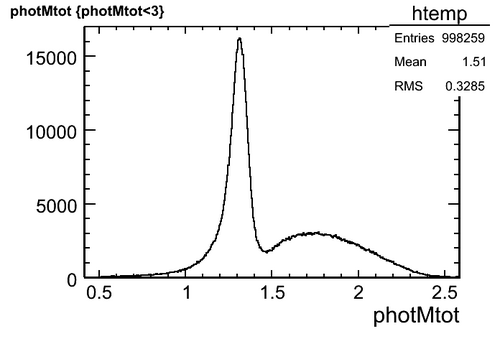Difference between revisions of "February 24, 2009 Physics"
From GlueXWiki
(→Tentative Agenda) |
|||
| Line 25: | Line 25: | ||
= Tentative Agenda = | = Tentative Agenda = | ||
| − | Questions: | + | *'''Questions:''' |
| − | + | # I can loop over all the photons, add their 4-momenta and calculate the mass of the a2(1320) and it gives me something reasonable, but how do I go about saying which photons were Pi0's and Eta's in order to cut on their mass? I think this is more code that needs to be written. Also, in the reconstruction code, there doesn't seem to be any way of saying that if 2 photons are pions with high confidence that the others are most likely Etas. And then adding their 4-momenta and calculating an A2 mass from that. | |
| + | # What's the large hump to the right of the a2(1320) peak below? (1 million A2 decays were thrown.) | ||
| − | |||
| − | |||
[[Image:PhotMtot.png|500px]] | [[Image:PhotMtot.png|500px]] | ||
| − | |||
| − | |||
The following code creates the data set for the above plot. No cuts have been applied. | The following code creates the data set for the above plot. No cuts have been applied. | ||
| Line 49: | Line 46: | ||
} | } | ||
photMtot = Gtot.M(); | photMtot = Gtot.M(); | ||
| − | |||
| − | |||
= Minutes = | = Minutes = | ||
Revision as of 19:41, 23 February 2009
Time: 11:00 EST/10:00 CST
- ESNET Number 8542553
- Phone:
- +1-800-377-8846 : US
- +1-888-276-7715 : Canada
- +1-302-709-8424 : International
- then enter participant code: 39527048# (remember the "#")
To do list from last meeting
- Next Steps:
- look at the a2 mass peak - adjust cuts on the eta and pi0 masses
- introduce Pythia background - skim off the wanted events by cutting on the total neutral energy (but we need to record the total number of events before skimming) - hd_filter is a good program example
- cut on eta and pi0 masses, then look at the effect on the different angular distributions (i.e. Gottfried-Jackson angles, etc.)
- Also:
- look at difference between reconstructed and generated z position for less than 65 cm
- look at single photon reconstruction efficiencies
- adjust the error matrix for the BCAL (look in PID/DPhoton_factory.cc)
Documents to Review
Tentative Agenda
- Questions:
- I can loop over all the photons, add their 4-momenta and calculate the mass of the a2(1320) and it gives me something reasonable, but how do I go about saying which photons were Pi0's and Eta's in order to cut on their mass? I think this is more code that needs to be written. Also, in the reconstruction code, there doesn't seem to be any way of saying that if 2 photons are pions with high confidence that the others are most likely Etas. And then adding their 4-momenta and calculating an A2 mass from that.
- What's the large hump to the right of the a2(1320) peak below? (1 million A2 decays were thrown.)
The following code creates the data set for the above plot. No cuts have been applied.
vector<const DPhoton*> photV;
loop->Get( photV );
nPhot = photV.size();
assert (nPhot < PID_PHOT_MAX) ;
nHits=0;
Etot=0;
DLorentzVector Gtot(0,0,0,0);
for( vector<const DPhoton*>::const_iterator photon = photV.begin(); photon != photV.end(); ++photon ){
Gtot += (**photon).lorentzMomentum();
}
photMtot = Gtot.M();
